Vietnamese Noodle Soup: How To Make And Where To Enjoy Authentic Phở?

Table of Contents
I. Introduction about Vietnamese Pho
1. The origin of Phở Vietnam
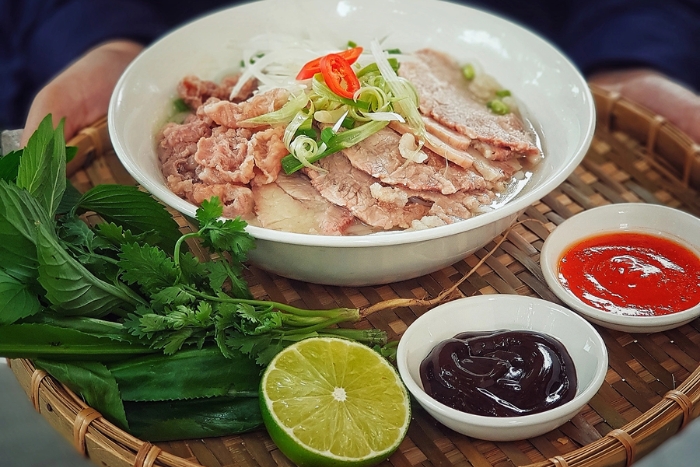
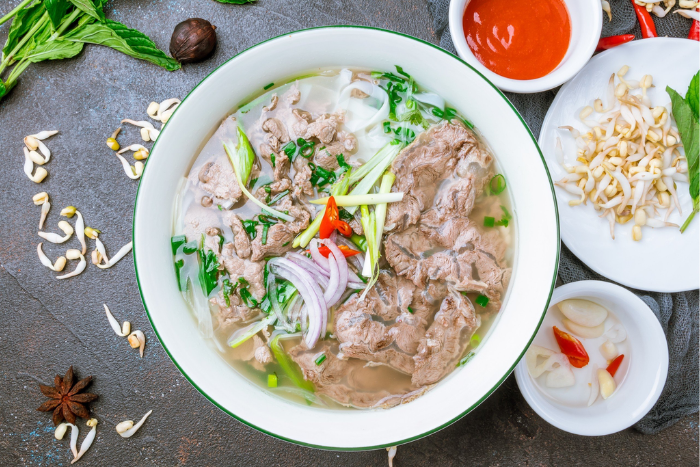
2. Components of Phở Vietnam
- Broth: The soul of authentique phở vietnam lies in its broth. It is typically made by simmering beef bones, oxtails, and various spices for hours to extract a rich, flavorful essence. Common spices include star anise, cloves, cinnamon, coriander seeds, and fennel seeds, which infuse the broth with a complex aroma.
- Noodles: Phở noodles are flat rice noodles, known for their delicate texture and ability to absorb the broth's flavours. They are often blanched briefly to achieve the perfect consistency before being served.
- Meat: Traditionally, phở is made with thinly sliced beef (such as sirloin or brisket), though variations with chicken (phở gà) are also popular. The beef is usually added raw and cooked by the hot broth, ensuring tenderness.
- Garnishes: Fresh herbs like cilantro, Thai basil, and mint are essential, adding freshness and vibrancy to the dish. Bean sprouts, lime wedges, and sliced chilli peppers provide crunch and a balance of flavours. Hoisin sauce and Sriracha are common accompaniments, allowing diners to customise their bowls to their taste.
3. Cultural significance
For many tourists, authentic pho is one of their first encounters with Vietnamese cuisine, if you haven't eaten pho, you haven't travelled to Vietnam. Its complex yet harmonious flavours offer a glimpse into the country's rich culinary traditions. Enjoying a bowl of phở in a bustling Hanoi street market or a cosy Saigon eatery can be a transformative experience, immersing travellers in the local culture and hospitality. This sensory introduction often sparks a deeper interest in Vietnamese food and culture, encouraging tourists to explore more of what the country has to offer. Additionally, Vietnamese pho has gained immense popularity in countries like the United States, Korea, and Japan due to its exceptional flavour and ease of consumption.
When exploring what is the best Phở in Vietnam, you'll find a delightful array of variations to satisfy any palate. Popular options include “Phở Tái,” featuring thinly sliced medium-rare steak, “Phở Chín,” with steamed lean beef, “Phở Nạm,” which combines steamed half-lean and half-fatty beef, “Pho Tai Nam,” blending both steamed half-lean and half-fatty beef with thinly sliced medium-rare steak, “Phở Gầu Bò,” showcasing steamed fatty beef, and “Phở Sốt Vang,” a unique version with beef tendon in a Vietnamese Bordelaise sauce. Each bowl is typically garnished with chopped ginger, scallions, yellow onions, and cilantro, allowing diners to tailor their meal to their taste. At Autour Asia Vietnam Travel Agency, we can help you discover the finest Phở spots, ensuring an unforgettable culinary adventure during your travels.
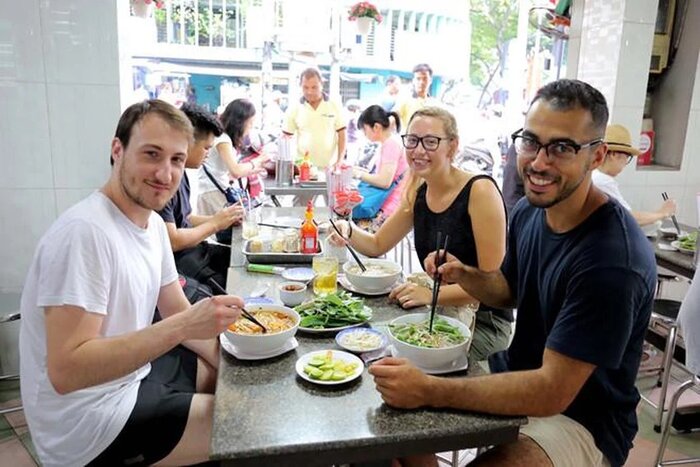
II. How to make Vietnamese noodle soup
1. Ingredients
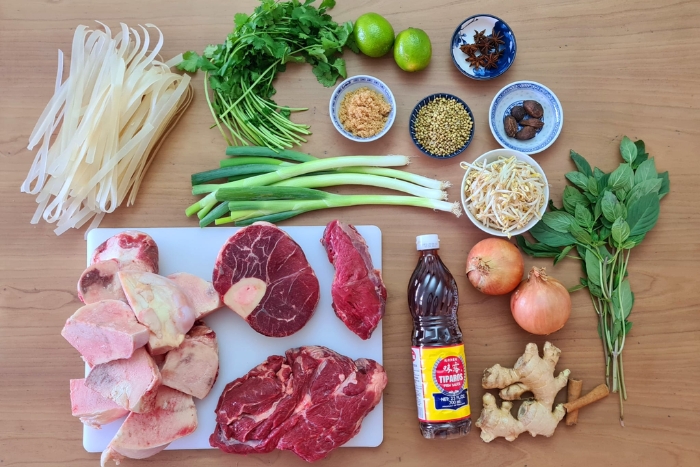
2. How to make authentic Pho?
a. Ingredients
1.5 kg beef bones (marrow bones, oxtail)
500g beef brisket or shank
1 large onion, halved
1 large piece of ginger, halved
5 star anise
4 whole cloves
2 cinnamon sticks
2 cardamom pods
1 tbsp coriander seeds
1-2 tbsp rock sugar (or regular sugar)
2 tbsp fish sauce
Salt to taste
Water
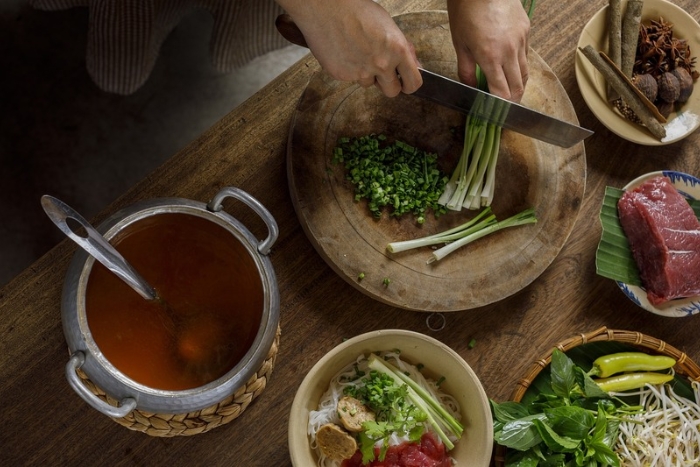
500g beef sirloin or eye of round, thinly sliced
1 package rice noodles (bánh phở)
Fresh herbs (Thai basil, cilantro, mint)
Bean sprouts
Lime wedges
Sliced chilli peppers (optional)
Hoisin sauce
Sriracha sauce
b. Instructions
- Roast the Bones and Meat:
- Preheat your oven to 200°C (400°F). Place the beef bones on a baking sheet and roast for 30-45 minutes until they turn brown.
- Char the onion and ginger over an open flame or in the oven until the skin is blackened. Peel off the charred skin.
- Toast the spices: In a dry skillet, toast the star anise, cloves, cinnamon sticks, cardamom pods, and coriander seeds over medium heat until they become fragrant.

- Simmer the Broth:
- Reduce the heat to low and simmer for 4-6 hours, skimming off any impurities to keep the broth clear.
- Season the Broth: Remove the bones, beef brisket, and spice bag from the pot. Add rock sugar, vietnamese fish sauce, and salt to taste.
- Strain the Broth: Strain the broth through a fine-mesh sieve or cheesecloth into a clean pot to remove any remaining solids.
- Cook the noodles: Cook the rice noodles according to the package instructions. Drain and rinse under cold water to prevent sticking.
- Slice the meat: Thinly slice the beef sirloin or eye of round. Partially freezing the meat makes it easier to slice thinly.
- Assemble the Phở:
- Divide the cooked noodles among four serving bowls.
- Arrange the raw beef slices on top of the noodles.
- Pour the hot broth over the noodles and beef to cook the meat.
- Garnish and Serve:
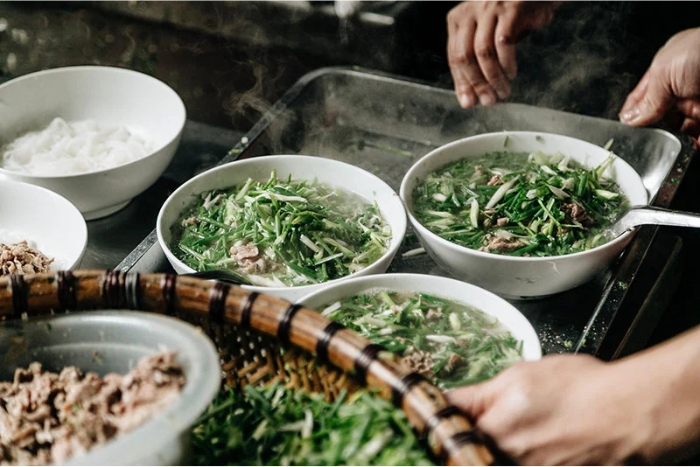
III. Where to enjoy authentic pho in Vietnam?
1. Best Pho in Hanoi

- Phở Bát Đàn - 49 Bat Dan Street, Hoan Kiem district, Hanoi
Google Maps: https://goo.gl/maps/hJTTrjffhYdSSxnm6
- Phở Thìn - 61 Dinh Tien Hoang Street, Hoan Kiem district, Hanoi
Google Map: https://goo.gl/maps/Bd7kQfAtrmgyfV1HA
- Phở Lý Quốc Sư - 10 Lý Quốc Sư Street, Hàng Trống, Hoàn Kiếm district, Hà Nội
Google Map: https://goo.gl/maps/n7UuTBnvkqqqEuQu7
2. Best Pho in Saigon
- Phở Hoa Pasteur: 260C Pasteur, District 3, Ho Chi Minh city
Google map: https://maps.app.goo.gl/PErUqVpUqriNHoM6A
- Pho 2000 Saigon: Le Thanh Ton Street, District 1, Ho Chi Minh city
Google map: https://maps.app.goo.gl/AMw54DNmWKv6L1LcA
- Phở Cao Vân : 25 Mac Dinh Chi Street, District 1, Ho Chi Minh City
Google map: https://maps.app.goo.gl/8DzytNx5CXR7oyL7A
In conclusion, mastering the art of making authentic pho at home allows you to experience the rich and aromatic flavours that make this Vietnamese noodle soup so beloved. With the right pho seasonings and techniques, you can create a bowl that rivals those found in the best eateries in Vietnam. Whether you're cooking in your kitchen or exploring the vibrant food scene in Vietnam, enjoying a bowl of Vietnamese phở is a journey into the heart of Vietnamese culture and cuisine. Savour each bite and appreciate the tradition and craftsmanship that go into every delicious spoonful.
>>> Vietnam Day Trips
>>> Vietnam Vacation 18 days
>>> Vietnam itinerary 3 weeks
>>> Vietnam Packagess Tours
Authentic Pho is nutritious and is high in protein, but does have high sodium and calories. It may help reduce inflammation and improve joint health. Pho (pronounced “fuh”) is a hearty Vietnamese soup usually made with a meaty broth, rice noodles, various herbs, and either beef, chicken, or tofu.
For making Vietnamese Pho, Chinese five spice is known as the best choice for an alternative to ground star anise since it is a prominent part of this spice combination. The mixture also includes earthy cloves, cinnamon, pepper, and fennel seeds. Chinese five spice can replace ground star anise in a recipe
Related travel guide
Other similar articles
CUSTOMIZABLE BY LOCAL EXPERTS
Personalized trip at the original price!
REFUND GUARANTEE
We believe in our work and promise to give you money back.
GOOD PRICE / QUALITY
95% satisfied more than expected!
24/7 LOCAL SUPPORT
We are always available online to provide assistance at any time.
Most read articles
Autour Asia is highly recommended on
Embracing the mission of "Satisfied more than expected" and providing authentic experiences, we have received numerous recommendations on reputable travel forums:























